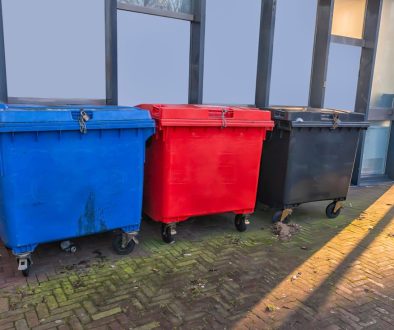Hazardous waste storage is a critical aspect of construction projects, particularly when dealing with potentially dangerous materials that pose risks to human health, safety, and the environment. As a family-run skip hire and aggregate company servicing Staffordshire, we understand the importance of secure hazardous waste storage in construction and the complexities that businesses face when working with such materials. To mitigate risks and ensure compliance with environmental regulations, proper handling and storage of hazardous waste should be a top priority throughout the lifecycle of a construction project.
In the construction industry, hazardous waste refers to any waste substance that, due to its physical, chemical, or biological characteristics, poses a potential threat to the environment or human health. Common hazardous waste materials in construction projects include asbestos, lead-based paint debris, contaminated soil, and spent solvents, among others. Implementing secure storage for hazardous waste is crucial for protecting workers, the surrounding community, and the environment while adhering to regulations designed to minimise the impact of such waste materials.
This blog post will focus on the importance of secure hazardous waste storage in construction projects, offering insights into best practices for handling and storing a wide range of potentially hazardous materials. Additionally, we will discuss the regulatory requirements related to hazardous waste and provide guidelines to assist construction businesses in staying compliant and minimising risks associated with these materials.
By implementing secure hazardous waste storage practices and partnering with experienced waste management providers, construction companies can ensure environmental responsibility and safety on their job sites. Join us as we delve into the significance of hazardous waste storage in construction, with a focus on best practices and regulatory compliance.
Identifying Hazardous Waste in Construction
The first step in ensuring secure hazardous waste storage in construction projects is to accurately identify these materials. By understanding the different types of hazardous waste specific to your project, you can implement appropriate storage and handling solutions. Common hazardous waste materials in construction include:
– Asbestos: Often found in insulation materials, asbestos poses significant health risks when disturbed.
– Lead-based paint debris: Older buildings may contain lead-based paint, which is toxic and harmful to humans and the environment.
– Contaminated soil: Soil from demolition sites or brownfield developments may contain hazardous substances, such as heavy metals or chemicals.
– Spent solvents: Various solvents used for cleaning or surface preparation can become hazardous waste when spent.
Regulatory Requirements for Hazardous Waste Storage
To ensure the safety and well-being of your team and the environment, it is essential to adhere to hazardous waste storage regulations set by authorities. These often include:
– Proper classification: Hazardous waste materials must be classified accurately according to regulatory guidelines.
– Labelling and signage: Containers should display clear labels and hazard symbols to inform workers about potential dangers.
– Secure containment: Storage containers must be designed and constructed to prevent leaks, spills, or other accidents.
– Location and separation: Hazardous waste storage areas should be adequately separated from other facilities or non-hazardous materials.
– Compliance with waste disposal regulations: Ensure that hazardous waste is disposed of properly according to applicable laws and directives.
Best Practices for Hazardous Waste Storage in Construction
Implementing proper hazardous waste storage practices is not only necessary for regulatory compliance but also crucial for the welfare of workers, nearby communities, and the environment. Some best practices for hazardous waste storage in construction projects include:
– Designated storage areas: Creating a dedicated area for hazardous waste storage can help contain the risks associated with these materials.
– Regularly inspect storage containers: Monitoring the condition of hazardous waste containers is essential to prevent potential leaks, spills, or other incidents.
– Training and education: Ensure that your team understands the risks associated with hazardous waste and the correct handling and storage procedures.
– Emergency response plan: Develop a robust emergency response plan for dealing with hazardous waste incidents should they occur on your construction site.
Partnering with Experts for Hazardous Waste Management
Collaborating with experienced waste management providers can greatly benefit your construction project in terms of hazardous waste storage and disposal:
– Expertise in hazardous waste management: Professionals with experience in managing hazardous waste can provide valuable knowledge and guidance to your project.
– Compliance assistance: Aligning with a reliable waste management provider can reduce potential regulatory risks and help ensure that your construction project complies with all hazardous waste storage and disposal requirements.
– Safe disposal solutions: Trusting a reputable waste management company with your hazardous waste ensures responsible and compliant disposal, reducing environmental impact and maximising safety.
Conclusion
Managing hazardous waste storage effectively and responsibly is essential for ensuring the safety and well-being of employees, nearby communities, and the environment. By understanding the different types of hazardous waste encountered in construction projects, adhering to regulatory requirements, implementing best practices, and partnering with experienced waste management providers, you can mitigate risks, maintain compliance, and achieve a higher level of environmental responsibility.
If you require support or guidance in secure hazardous waste storage for your construction project, our knowledgeable team at Enviro Skip Hire can provide tailored solutions that prioritise safety and environmental responsibility. Let’s work together to manage hazardous waste effectively and contribute to a safer and cleaner construction industry for all involved.




